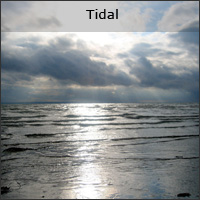Energy Sources
Electricity generation involves the transfer of energy from one form to another. The energy sources used in the generation of energy can be classified as two types.
- Non renewable energy source
- Renewable energy source
Renewable energy sources
These are energy sources that are unlimited (will never run out) and once used are rapidly replenished (continuously replaced).
Examples of renewable energy sources are wind, water, geothermal and solar.
The table below is a summary of non renewable energy resources:
Solar

This is energy from sunlight. Sunlight can be captured by solar panels and its energy transferred to electricity. Energy from the sun can also be focussed onto pipes carrying water transferring heat energy.
- Free unlimited source of energy
- No waste or greenhouse gases produced.
- Source not available at night.
- Can be an unreliable source of energy unless in a country with a hot climate.
Wind

Wind is created by the action of warm air rising and cold air blowing to fill the void created. Hence, the source is the sun as it is its energy that warms the air.
- Wind is free.
- No waste or greenhouse gases produced.
- Unpredictable source of energy.
- Wind farms can be unsightly and cause noise pollution.
Tidal

The pulling effect of the moon on the earth causes the oceans and seas to rise and fall. The movement of the rise and fall of the oceans and seas can be used to drive turbines.
- A free source of energy.
- No waste or greenhouse gases produced.
- Tides are predictable.
- Tidal barrages can affect the natural habitat of wildlife and impact the environment.
- Can only supply energy when the tide is moving in or out.
Hydro

Water stored in a large volume in a reservoir behind a dam. The potential energy of the water can be transferred to kinetic energy in the turbines.
- Once the dam is built the energy is free.
- No waste or greenhouse gases produced.
- Very reliable source of energy.
- Dams are very expensive to build.
- Dams cause flooding which seriously impact the environment and local habitats.
Waves

Waves are produced by the action of the wind on the seas and oceans.
- A free source of energy.
- No waste or greenhouse gases produced.
- Dependant on the strength of the waves.
- Needs to be capable of withstanding rough weather.
- Sites are limited to only areas where the waves are consistently strong.
Geothermal

Heat from under the earth in volcanic regions is used to heat water to produce steam for running turbines for generating electricity. In some cases it is used to heat water for heating.
- No fuel needed
- Does no contribute to greenhouse gases
- Limited sites available.
- Hazardous gases can be released from geothermal sites which require safe disposal.
Biomass

This is fuel obtained from decaying plant and animal material. Wood is one source as it can be burnt to provide heat energy. Sugar cane can be fermented to produce alcohol which can be used as a fuel.
- Is a renewable source as long as plant and trees are replaced.
- Cheap and easily available source of fuel.
- Produces greenhouse gases.
